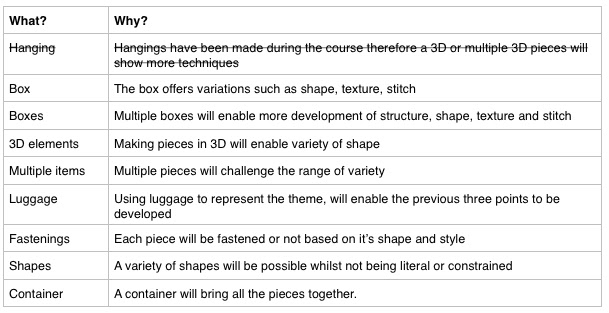Favourite Destinations
Assessment Piece based on the theme ‘Going Places’
Ideas, techniques and stitching to develop further -
quilting
metal
long and short free embroidered stitch
gilding
3D structures
strong fabrics e.g. leather
fastenings
fringing
What and why?
The hanging idea was dismissed and a container or support holding a range of 3D boxes/luggage will be developed using a range of techniques, stitches, textures and finishes.
Research
A photograph of a luggage trolley in Calcutta station provided inspiration for the final sample - lots of boxes (luggage) with a small variety of shapes, colours and sizes were neatly stacked on a fairly rickety trolley and held stable with a ‘bungee’
A group of us were travelling by from Calcutta to Bubaneshwar in the Bay of Bengal area. Only soft luggage was permitted.
Magazines and observations have been used to consider what shapes the luggage pieces might me. Some of the possible fabrics and textures would speak for themselves. e.g. leather would suggest a brief case.
The piece
This piece will be developed using as broad a range of techniques and stitches learnt during the course work. So, the bases for the stitching will also be from as broad a range as can be stitched and shaped into 3D structures.
A range of bases silk, water soluble, organza, calico, cotton, metals, wine bottle collars wood, paper etc
A range of threads thick and thin, metal, wool etc.
A range of stitching cable, granite, long and short, free and automatic stitching, fringing, faux chenille
A range of structures /shapes
A range of embellishments Gilding, metallics etc
A range of techniques quilting, soldering, burning, water soluble, supported and
unsupported
A containing structure decorated in a range of techniques to hold the other 3D elements
The design
Each of the 3D ‘pieces of luggage’ will be designed using a shape that works with the material based on a paper pattern for each previously modelled. The relationship between each piece will be that they are in principle containers that may be able to be opened, are open or are a closed piece.
Planning
I am going to make a luggage trolley which will carry 14 pieces of ‘luggage’ all of which will be created using a range of materials and techniques
Design elements
Colour
Each piece will be able to stand alone, some will be mono-tonal and some brightly coloured using the fabric and stitch to create the visual impact. Collectively they will provide an interesting journey in themselves to explore each piece individually or together.
Line
Each piece will follow either simple or complex line form using a range of stitch techniques and thread thicknesses and materials.
Shape and form
Each piece will have it’s own shape and form. Some will be complex and some uncomplicated - where an interior finish is needed to create an overall impression it will be included. Some of the pieces will not require an interior finish.
Texture
Each piece will have its own visual texture. Some will be simple and some more complex dependent on the material base and stitch/embellishment finishes. There will be a range of textures; cold and sharp stitched metals, soft chenille and cable stitched; hard and rough wood and some more delicate and pretty.
Composition
The pieces will be brought together to form a bold, bright, complex whole. Colour, form and texture will take the viewer’s eye around and into the construction with a range of focal points.
Quality
The piece will be interesting and appear to look robust and heavy, whilst in fact each element will in itself be a hollow box, so light and in some samples, quite fragile.
Materials
This final sample will use as many materials as can practically be used to create the pieces of luggage and the trolley as can be worked on the machine - some will need hand finishing.
It is the intention to use a broad and diverse range of materials, natural and man-made to complete elements of the sample.
Background/base
The base of each of the samples will be determined for the materials to be used for each, however the support for all the boxes will be a ‘luggage trolley’ using a wooden bread tray which will be cut to shape, handles, wheels and supports added and embellished with stitched fabrics, tassels etc to bring the piece into place - the place was India - so the trolley will reflect that
Fabrics
Metal and wood, silk, organza, silk rods, metal mesh, gilding, leather and other more basic fabrics such as cottons and calico will be used
Threads
A broad range of threads will be used for the range of boxes and the trolley. Thick cords, metal cords and wool for cable stitch, glove thread for leather and texture, metallics will be used widely and 40s used for some stitching. Matt and shiny threads will be used where appropriate.
Construction
Size
Each smaller piece will be appropriate to the supporting trolley and the overall piece approximately 10” x 6” x 6”.
Stitches
Free, automatic, cable, granite, long and short holes without thread in metal and as much innovation will be employed in the pieces that constitute the whole.
Edges
Each box will need to be edged to form the flat material - different techniques will be used as required
Finishing
Each box will require it’s own finish, so handles, loops, paper buttons, and catches will be developed for each piece. Some will be lidded boxes without a finishing catch or handle. Most will have a finishing element. All with have destination labels. The destination is ‘home’ so LHR.







No comments:
Post a Comment